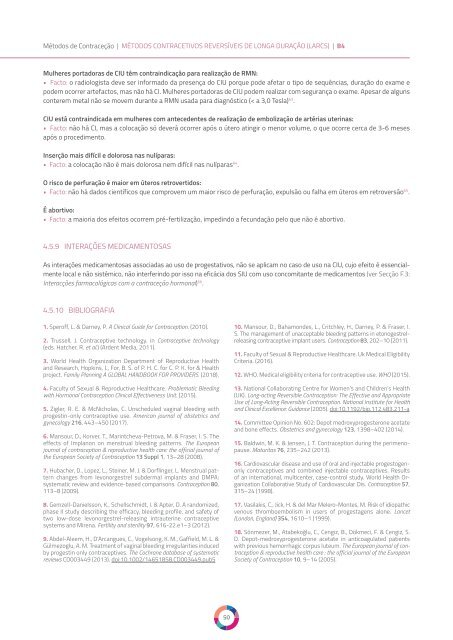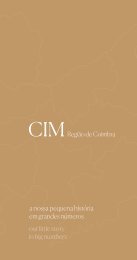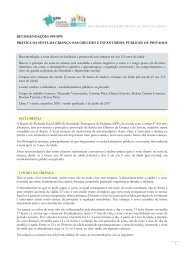CONSENSO SOBRE CONTRACEÇÃO 2020
Create successful ePaper yourself
Turn your PDF publications into a flip-book with our unique Google optimized e-Paper software.
Métodos de Contraceção | MÉTODOS CONTRACETIVOS REVERSÍVEIS DE LONGA DURAÇÃO (LARCS) | B4<br />
Mulheres portadoras de CIU têm contraindicação para realização de RMN:<br />
• Facto: o radiologista deve ser informado da presença do CIU porque pode afetar o tipo de sequências, duração do exame e<br />
podem ocorrer artefactos, mas não há CI. Mulheres portadoras de CIU podem realizar com segurança o exame. Apesar de alguns<br />
conterem metal não se movem durante a RMN usada para diagnóstico (< a 3,0 Tesla) 63 .<br />
CIU está contraindicada em mulheres com antecedentes de realização de embolização de artérias uterinas:<br />
• Facto: não há CI, mas a colocação só deverá ocorrer após o útero atingir o menor volume, o que ocorre cerca de 3-6 meses<br />
após o procedimento.<br />
Inserção mais difícil e dolorosa nas nulíparas:<br />
• Facto: a colocação não é mais dolorosa nem difícil nas nulíparas 64 .<br />
O risco de perfuração é maior em úteros retrovertidos:<br />
• Facto: não há dados científicos que comprovem um maior risco de perfuração, expulsão ou falha em úteros em retroversão 65 .<br />
É abortivo:<br />
• Facto: a maioria dos efeitos ocorrem pré-fertilização, impedindo a fecundação pelo que não é abortivo.<br />
4.5.9 INTERAÇÕES MEDICAMENTOSAS<br />
As interações medicamentosas associadas ao uso de progestativos, não se aplicam no caso de uso na CIU, cujo efeito é essencialmente<br />
local e não sistémico, não interferindo por isso na eficácia dos SIU com uso concomitante de medicamentos (ver Secção F.3:<br />
Interacções farmacológicas com a contraceção hormonal) 66 .<br />
4.5.10 BIBLIOGRAFIA<br />
1. Speroff, L. & Darney, P. A Clinical Guide for Contraception. (2010).<br />
2. Trussell, J. Contraceptive technology. in Contraceptive technology<br />
(eds. Hatcher, R. et al.) (Ardent Media, 2011).<br />
3. World Health Organization Department of Reproductive Health<br />
and Research, Hopkins, J., For, B. S. of P. H. C. for C. P. K. for & Health<br />
project. Family Planning A GLOBAL HANDBOOK FOR PROVIDERS. (2018).<br />
4. Faculty of Sexual & Reproductive Healthcare. Problematic Bleeding<br />
with Hormonal Contraception Clinical Effectiveness Unit. (2015).<br />
5. Zigler, R. E. & McNicholas, C. Unscheduled vaginal bleeding with<br />
progestin-only contraceptive use. American journal of obstetrics and<br />
gynecology 216, 443–450 (2017).<br />
6. Mansour, D., Korver, T., Marintcheva-Petrova, M. & Fraser, I. S. The<br />
effects of Implanon on menstrual bleeding patterns. The European<br />
journal of contraception & reproductive health care: the official journal of<br />
the European Society of Contraception 13 Suppl 1, 13–28 (2008).<br />
7. Hubacher, D., Lopez, L., Steiner, M. J. & Dorflinger, L. Menstrual pattern<br />
changes from levonorgestrel subdermal implants and DMPA:<br />
systematic review and evidence-based comparisons. Contraception 80,<br />
113–8 (2009).<br />
8. Gemzell-Danielsson, K., Schellschmidt, I. & Apter, D. A randomized,<br />
phase II study describing the efficacy, bleeding profile, and safety of<br />
two low-dose levonorgestrel-releasing intrauterine contraceptive<br />
systems and Mirena. Fertility and sterility 97, 616-22.e1–3 (2012).<br />
9. Abdel-Aleem, H., D’Arcangues, C., Vogelsong, K. M., Gaffield, M. L. &<br />
Gülmezoglu, A. M. Treatment of vaginal bleeding irregularities induced<br />
by progestin only contraceptives. The Cochrane database of systematic<br />
reviews CD003449 (2013). doi:10.1002/14651858.CD003449.pub5<br />
10. Mansour, D., Bahamondes, L., Critchley, H., Darney, P. & Fraser, I.<br />
S. The management of unacceptable bleeding patterns in etonogestrelreleasing<br />
contraceptive implant users. Contraception 83, 202–10 (2011).<br />
11. Faculty of Sexual & Reproductive Healthcare. Uk Medical Eligibility<br />
Criteria. (2016).<br />
12. WHO. Medical eligibility criteria for contraceptive use. WHO (2015).<br />
13. National Collaborating Centre for Women’s and Children’s Health<br />
(UK). Long-acting Reversible Contraception: The Effective and Appropriate<br />
Use of Long-Acting Reversible Contraception. National Institute for Health<br />
and Clinical Excellence: Guidance (2005). doi:10.1192/bjp.112.483.211-a<br />
14. Committee Opinion No. 602: Depot medroxyprogesterone acetate<br />
and bone effects. Obstetrics and gynecology 123, 1398–402 (2014).<br />
15. Baldwin, M. K. & Jensen, J. T. Contraception during the perimenopause.<br />
Maturitas 76, 235–242 (2013).<br />
16. Cardiovascular disease and use of oral and injectable progestogenonly<br />
contraceptives and combined injectable contraceptives. Results<br />
of an international, multicenter, case-control study. World Health Organization<br />
Collaborative Study of Cardiovascular Dis. Contraception 57,<br />
315–24 (1998).<br />
17. Vasilakis, C., Jick, H. & del Mar Melero-Montes, M. Risk of idiopathic<br />
venous thromboembolism in users of progestagens alone. Lancet<br />
(London, England) 354, 1610–1 (1999).<br />
18. Sönmezer, M., Atabekoğlu, C., Cengiz, B., Dökmeci, F. & Cengiz, S.<br />
D. Depot-medroxyprogesterone acetate in anticoagulated patients<br />
with previous hemorrhagic corpus luteum. The European journal of contraception<br />
& reproductive health care : the official journal of the European<br />
Society of Contraception 10, 9–14 (2005).<br />
50

















